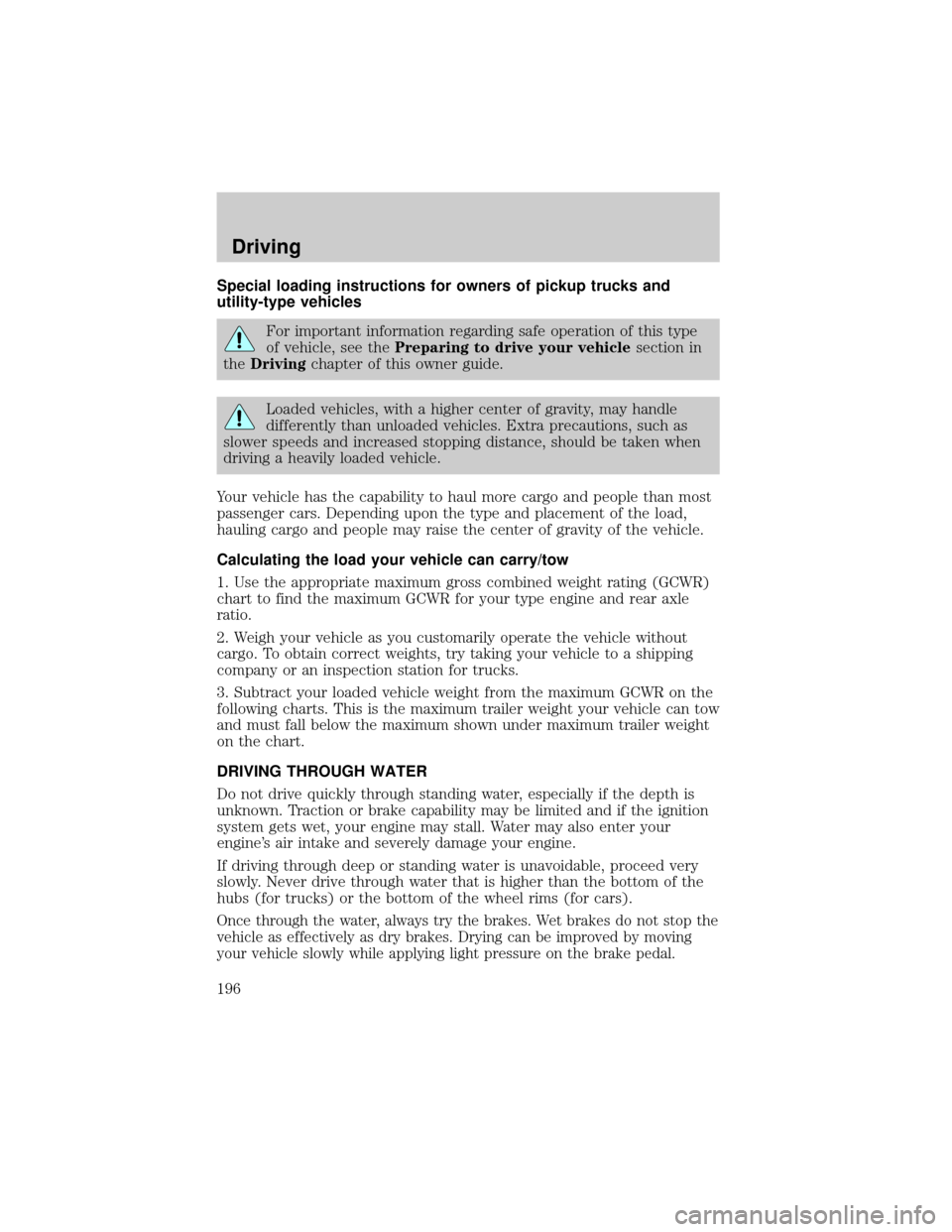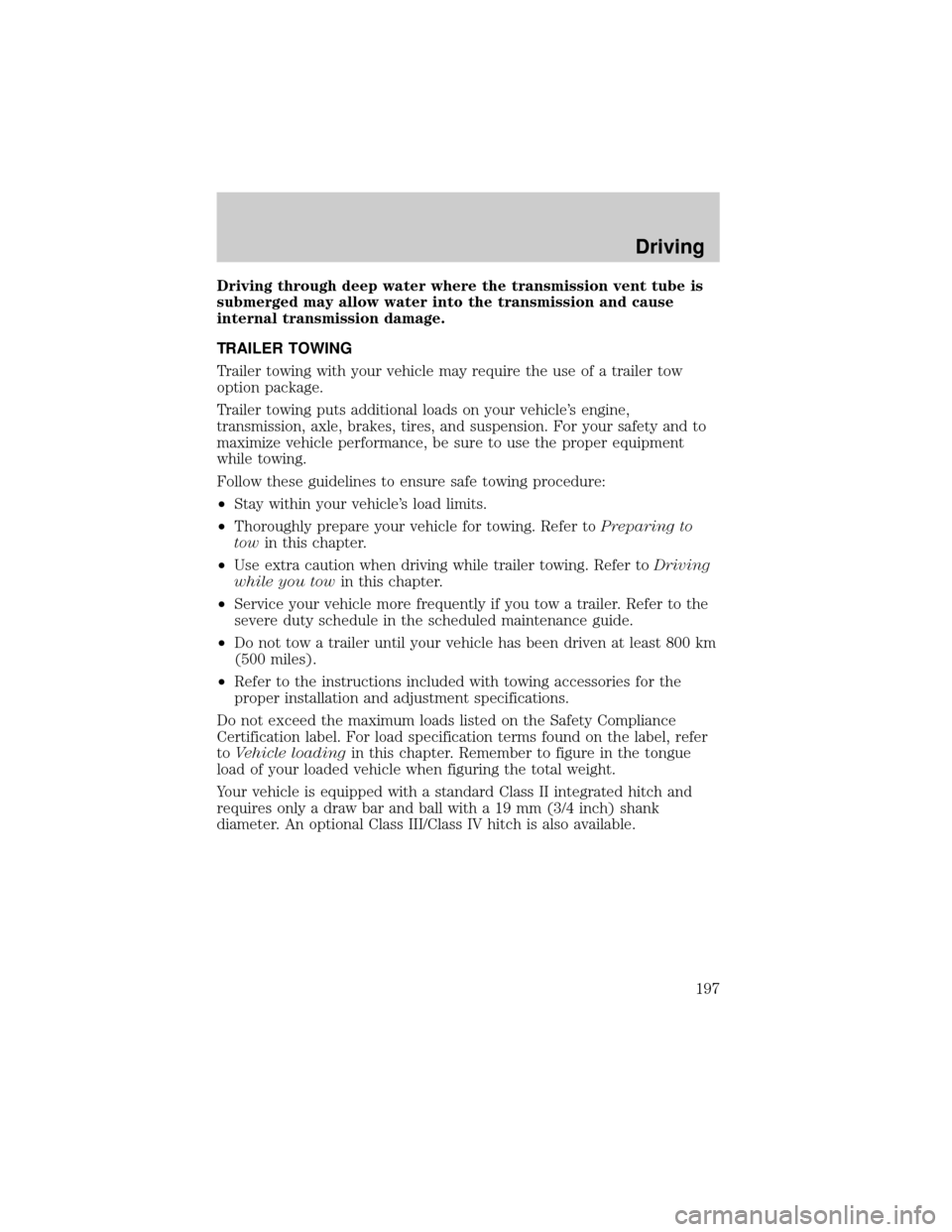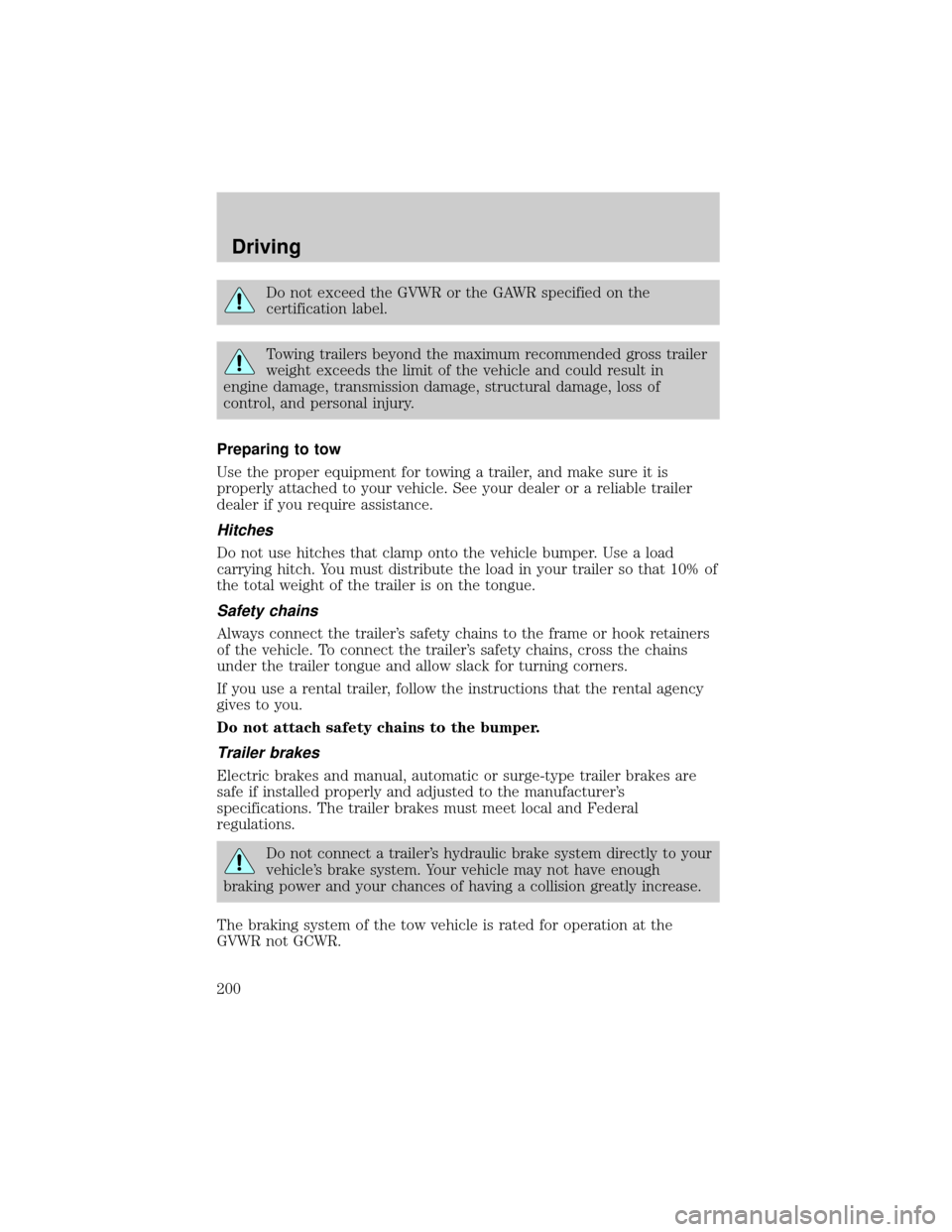2002 FORD EXPLORER brakes
[x] Cancel search: brakesPage 196 of 312

Special loading instructions for owners of pickup trucks and
utility-type vehicles
For important information regarding safe operation of this type
of vehicle, see thePreparing to drive your vehiclesection in
theDrivingchapter of this owner guide.
Loaded vehicles, with a higher center of gravity, may handle
differently than unloaded vehicles. Extra precautions, such as
slower speeds and increased stopping distance, should be taken when
driving a heavily loaded vehicle.
Your vehicle has the capability to haul more cargo and people than most
passenger cars. Depending upon the type and placement of the load,
hauling cargo and people may raise the center of gravity of the vehicle.
Calculating the load your vehicle can carry/tow
1. Use the appropriate maximum gross combined weight rating (GCWR)
chart to find the maximum GCWR for your type engine and rear axle
ratio.
2. Weigh your vehicle as you customarily operate the vehicle without
cargo. To obtain correct weights, try taking your vehicle to a shipping
company or an inspection station for trucks.
3. Subtract your loaded vehicle weight from the maximum GCWR on the
following charts. This is the maximum trailer weight your vehicle can tow
and must fall below the maximum shown under maximum trailer weight
on the chart.
DRIVING THROUGH WATER
Do not drive quickly through standing water, especially if the depth is
unknown. Traction or brake capability may be limited and if the ignition
system gets wet, your engine may stall. Water may also enter your
engine's air intake and severely damage your engine.
If driving through deep or standing water is unavoidable, proceed very
slowly. Never drive through water that is higher than the bottom of the
hubs (for trucks) or the bottom of the wheel rims (for cars).
Once through the water, always try the brakes. Wet brakes do not stop the
vehicle as effectively as dry brakes. Drying can be improved by moving
your vehicle slowly while applying light pressure on the brake pedal.
Driving
196
Page 197 of 312

Driving through deep water where the transmission vent tube is
submerged may allow water into the transmission and cause
internal transmission damage.
TRAILER TOWING
Trailer towing with your vehicle may require the use of a trailer tow
option package.
Trailer towing puts additional loads on your vehicle's engine,
transmission, axle, brakes, tires, and suspension. For your safety and to
maximize vehicle performance, be sure to use the proper equipment
while towing.
Follow these guidelines to ensure safe towing procedure:
²Stay within your vehicle's load limits.
²Thoroughly prepare your vehicle for towing. Refer toPreparing to
towin this chapter.
²Use extra caution when driving while trailer towing. Refer toDriving
while you towin this chapter.
²Service your vehicle more frequently if you tow a trailer. Refer to the
severe duty schedule in the scheduled maintenance guide.
²Do not tow a trailer until your vehicle has been driven at least 800 km
(500 miles).
²Refer to the instructions included with towing accessories for the
proper installation and adjustment specifications.
Do not exceed the maximum loads listed on the Safety Compliance
Certification label. For load specification terms found on the label, refer
toVehicle loadingin this chapter. Remember to figure in the tongue
load of your loaded vehicle when figuring the total weight.
Your vehicle is equipped with a standard Class II integrated hitch and
requires only a draw bar and ball with a 19 mm (3/4 inch) shank
diameter. An optional Class III/Class IV hitch is also available.
Driving
197
Page 200 of 312

Do not exceed the GVWR or the GAWR specified on the
certification label.
Towing trailers beyond the maximum recommended gross trailer
weight exceeds the limit of the vehicle and could result in
engine damage, transmission damage, structural damage, loss of
control, and personal injury.
Preparing to tow
Use the proper equipment for towing a trailer, and make sure it is
properly attached to your vehicle. See your dealer or a reliable trailer
dealer if you require assistance.
Hitches
Do not use hitches that clamp onto the vehicle bumper. Use a load
carrying hitch. You must distribute the load in your trailer so that 10% of
the total weight of the trailer is on the tongue.
Safety chains
Always connect the trailer's safety chains to the frame or hook retainers
of the vehicle. To connect the trailer's safety chains, cross the chains
under the trailer tongue and allow slack for turning corners.
If you use a rental trailer, follow the instructions that the rental agency
gives to you.
Do not attach safety chains to the bumper.
Trailer brakes
Electric brakes and manual, automatic or surge-type trailer brakes are
safe if installed properly and adjusted to the manufacturer's
specifications. The trailer brakes must meet local and Federal
regulations.
Do not connect a trailer's hydraulic brake system directly to your
vehicle's brake system. Your vehicle may not have enough
braking power and your chances of having a collision greatly increase.
The braking system of the tow vehicle is rated for operation at the
GVWR not GCWR.
Driving
200
Page 240 of 312

BRAKE FLUIDAND CLUTCH FLUID
Checking and adding brake fluid/clutch fluid
When equipped with a manual
transmission, your vehicle uses the
same reservoir for brake and clutch
fluid.
Brake/clutch fluid should be
checked and refilled as needed.
Refer to the scheduled maintenance
guide for the service interval
schedules.
1. Clean the reservoir cap before
removal to prevent dirt or water from entering the reservoir.
2. Visually inspect the fluid level.
3. If necessary, add brake/clutch
fluid from a clean un-opened
container until the level reaches
MAX. Do not fill above this line.
4. Use only a DOT 3 brake/clutch
fluid certified to meet Ford specifications. Refer toLubricant
specificationsin theCapacities and specificationschapter.
Brake fluid/clutch fluid is toxic. If brake/clutch fluid contacts the
eyes, flush eyes with running water for 15 minutes. Seek medical
attention if irritation persists. If taken internally, drink water and
induce vomiting. Seek medical attention immediately.
If you use a brake fluid that is not DOT 3, you will cause
permanent damage to your brakes.
Do not let the reservoir for the master cylinder run dry. This
may cause the brakes to fail.
MAX
Maintenance and care
240
Page 278 of 312

Remove any exterior accessories, such as antennas, before entering a car
wash. If you have wax applied to the vehicle at a commercial car wash, it
is recommended that you clean the wiper blades and windshield as
described inCleaning the wiper blades and windshield.
After washing, apply the brakes several times to dry them.
Underbody
Flush the complete underside of vehicle frequently. Keep body drain
holes unplugged. Inspect for road damage.
Waxing your vehicle
Waxing your vehicle on a regular basis will reduce minor scratches and
paint damage.
Wax when water stops beading on the surface. This could be every three
or four months, depending on operating conditions.
Use only carnauba or synthetic-based waxes. Use a cleaning fluid with a
clean cloth to remove any bugs before waxing your vehicle. Use tar
remover to remove any tar spots.
Avoid getting wax on the windshield, or on any surfaces which appear
coarse or bumpy. If you have wax applied at a commercial car wash, it is
recommended that you clean the wiper blades and windshield as
described inCleaning the wiper blades and windshield.
Repairing paint chips
Minor scratches or paint damage from road debris may be repaired with
the Ultra Touch Prep and Finishing Kit (#F7AZ-19K507±BA), Lacquer
Touch-up Paint (#ALBZ-19500±XXXXA), or Exterior Acrylic Spray
Lacquer (#ALAZ-19500±XXXXA) from the Ford Car Care Chemicals line.
Please note that the part numbers (shown as XXXX above) will vary with
your vehicle's specific coloring. Observe the application instructions on
the products.
Remove particles such as bird droppings, tree sap, insect remains, tar
spots, road salt and industrial fallout immediately.
Cleaning the engine
Engines are more efficient when they are clean because grease and dirt
buildup keep the engine warmer than normal. When washing:
Maintenance and care
278
Page 304 of 312

A
Air bag supplemental
restraint system ................155, 159
and child safety seats ............157
description ......................155, 159
disposal ....................................162
driver air bag ..................157, 160
indicator light ...........10, 159, 161
operation .........................157, 160
passenger air bag ...........157, 160
side air bag ..............................159
Air cleaner filter .......................283
Air conditioning ..........................33
automatic temperature
control system ..........................37
auxiliary heater and air
conditioner ................................46
rear seat controls .....................47
Ambulance packages ....................3
Antifreeze
(see Engine coolant) ................241
Anti-lock brake system
(see Brakes) ......................176±177
Anti-theft system ......................125
arming the system ..................125
disarming a
triggered system .....................126
warning light .............................11
Audio system (see Radio) ...51, 74
Automatic transmission
driving an automatic
overdrive .................................182
fluid, adding ............................248
fluid, checking ........................248
fluid, refill capacities ..............283
fluid, specification ..................287
Auxiliary power point ...............112Axle
lubricant specifications ..285, 287
refill capacities ........................283
traction lok ..............................194
B
Battery .......................................251
acid, treating emergencies .....251
charging system
warning light .............................11
jumping a disabled battery ....222
maintenance-free ....................251
replacement, specifications ...283
servicing ..................................251
voltage gauge ............................16
Belt minder ...............................151
Brakes ........................................176
anti-lock ...........................176±177
anti-lock brake system
(ABS) warning light .........11, 177
brake warning light ..................10
fluid, checking and adding ....240
fluid, refill capacities ..............283
fluid, specifications .........285, 287
lubricant specifications ..285, 287
parking ....................................177
pedals (see Power
adjustable foot pedals) ............30
shift interlock ..........................180
Break-in period .............................3
C
Capacities for refilling fluids ....283
Cargo cover ...............................115
Certification Label ....................289
Child safety restraints ..............162
child safety belts ....................162
Index
304
Page 308 of 312

fog lamps ...................................28
headlamps .................................28
headlamps, flash to pass ..........29
instrument panel, dimming .....29
interior lamps .........................102
replacing bulbs ...............270±274
Lane change indicator
(see Turn signal) ........................89
Liftgate ..............................114, 117
Lights, warning and indicator ......8
air bag ........................................10
anti-lock brakes (ABS) ....11, 177
anti-theft ...................................11
brake ..........................................10
charging system ........................11
cruise indicator .........................12
door ajar ....................................12
fuel cap light .............................10
high beam .................................11
overdrive off ..............................12
safety belt .................................10
service engine soon ....................8
speed control ............................95
turn signal indicator .................11
Load limits .................................194
GAWR ......................................194
GVWR ......................................194
trailer towing ..........................194
Loading instructions .................196
Locks
autolock ...................................124
childproof ................................110
doors ........................................109
Lubricant specifications ...285, 287
Lumbar support, seats .............135
M
Manual transmission .................185fluid capacities ........................283
lubricant specifications ..........287
reverse .....................................187
Message center ...........................19
english/metric button ...............23
system check button ................24
warning messages .....................24
Mirrors .......................................108
automatic dimming
rearview mirror .......................107
cleaning ...................................282
fold away .................................111
heated ......................................111
programmable memory ..........117
side view mirrors (power) .....110
Moon roof ..................................102
Motorcraft parts ................265, 283
O
Octane rating ............................262
Odometer .....................................15
Oil (see Engine oil) ..................235
P
Panic alarm feature,
remote entry system ................117
Parking brake ............................177
Parts (see Motorcraft parts) ....283
Pedals (see Power
adjustable foot pedals) ...............30
Power adjustable foot pedals .....30
Power distribution box
(see Fuses) ...............................213
Power door locks ......................109
Power steering ..........................178
Index
308